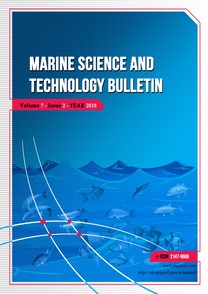Fish Spoilage Classification Based on Color Distribution Analysis of Eye Images
Fish Spoilage Classification Based on Color Distribution Analysis of Eye Images
Automated, Cluster, Evaluation, Fish Spoilage,
___
- Agustyawan, A. (2021). Fresh and not fresh fish dataset. Retrieved on January 29, 2023, from https://www.kaggle.com/datasets/arifagustyawan/fresh-and-not-fresh-fish-dataset
- Azeriee, A. A., Hashim, H., Jarmin, R., & Ahmad, A. (2009). A study on freshness of fish by using fish freshness meter. In 2009 5th international colloquium on signal processing & its applications (pp. 215–219).
- Dowlati, M., Mohtasebi, S. S., Omid, M., Razavi, S. H., Jamzad, M., & De La Guardia, M. (2013). Freshness assessment of gilthead sea bream (Sparus aurata) by machine vision based on gill and eye color changes. Journal of Food Engineering, 119(2), 277–287. https://doi.org/10.1016/j.jfoodeng.2013.05.023
- Herrero, A. M. (2008). Raman spectroscopy a promising technique for quality assessment of meat and fish: A review. Food Chemistry, 107(4), 1642–1651. https://doi.org/10.1016/j.foodchem.2007.10.014
- Issac, A., Dutta, M. K., & Sarkar, B. (2017). Computer vision based method for quality and freshness check for fish from segmented gills. Computers and Electronics in Agriculture, 139, 10–21. https://doi.org/10.1016/j.compag.2017.05.006
- Jarmin, R., Khuan, L. Y., Hashim, H., & Rahman, N. H. A. (2012). A comparison on fish freshness determination method. In Proceedings of the 2012 International Conference on System Engineering and Technology, Bandung, Indonesia. pp. 1-6.
- Lalabadi, H. M., Sadeghi, M., & Mireei, S. A. (2020). Fish freshness categorization from eyes and gills color features using multi-class artificial neural network and support vector machines. Aquacultural Engineering, 90, 102076. https://doi.org/10.1016/j.aquaeng.2020.102076
- Lehane, L., & Olley, J. (2000). Histamine fish poisoning revisited. International journal of food microbiology, 58(1-2), 1-37.
- MacQueen, J. (1967). Some methods for classification and analysis of multivariate observations., Proceedings of the 5th Berkeley Symposium on Mathematical Statistics and Probability Volume 1: Statistics, University of California Press. pp. 281-297.
- Muhamad, F., Hashim, H., Jarmin, R., & Ahmad, A. (2009). Fish freshness classification based on image processing and fuzzy logic. Recent Advances in Circuits, Systems, Electronics, Control and Signal Processing: Proceedings of the 8th WSEAS International Conference on Circuits, Systems, Electronics, Control & Signal Processing (CSECS '09), Puerto de la Cruz, Tenerife, Canary Islands, Spain. pp. 109–115.
- Novotny, L., Dvorska, L., Lorencova, A., Beran, V., & Pavlik, I. (2004). Fish: A potential source of bacterial pathogens for human beings. Veterinarni Medicina, 49(9), 343.
- Osman, H., Suriah, A., & Law, E. (2001). Fatty acid composition and cholesterol content of selected marine fish in Malaysian waters. Food Chemistry, 73(1), 55–60. https://doi.org/10.1016/S0308-8146(00)00277-6
- Pons-Sánchez-Cascado, S., Vidal-Carou, M., Nunes, M., & Veciana-Nogues, M. (2006). Sensory analysis to assess the freshness of Mediterranean anchovies (Engraulis encrasicholus) stored in ice. Food Control, 17(7), 564–569. https://doi.org/10.1016/j.foodcont.2005.02.016
- Rawat, S. (2015). Food spoilage: Microorganisms and their prevention. Asian Journal of Plant Science and Research, 5(4), 47–56.
- Sheng, L., & Wang, L. (2021). The microbial safety of fish and fish products: Recent advances in understanding its significance, contamination sources, and control strategies. Comprehensive Reviews in Food Science and Food Safety, 20(1), 738–786. https://doi.org/10.1111/1541-4337.12671
- Shewan, J., MacIntosh, R. G., Tucker, C., & Ehrenberg, A. (1953). The development of a numerical scoring system for the sensory assessment of the spoilage of wet white fish stored in ice. Journal of the Science of Food and Agriculture, 4(6), 283–298. https://doi.org/10.1002/jsfa.2740040607
- Uauy, R., & Dangour, A. D. (2006). Nutrition in brain development and aging: role of essential fatty acids. Nutrition Reviews, 64(suppl 2), S24–S33. https://doi.org/10.1301/nr.2006.may.s24-s33
- Vajdi, M., Varidi, M. J., Varidi, M., & Mohebbi, M. (2019). Using electronic nose to recognize fish spoilage with an optimum classifier. Journal of Food Measurement and Characterization, 13, 1205–1217. https://doi.org/10.1007/s11694-019-00036-4
- Venugopal, V. (2002). Biosensors in fish production and quality control. Biosensors and Bioelectronics, 17(3), 147–157. https://doi.org/10.1016/S0956-5663(01)00180-4
- Vuori, H. (1992). Quality assurance in Finland. British Medical Journal, 304(6820), 162-164.
- Weichselbaum, E., Coe, S., Buttriss, J., & Stanner, S. (2013). Fish in the diet: A review. Nutrition Bulletin, 38(2), 128–177. https://doi.org/10.1111/nbu.12021
- Zhang, J., Sasaki, S., Amano, K., & Kesteloot, H. (1999). Fish consumption and mortality from all causes, ischemic heart disease, and stroke: an ecological study. Preventive Medicine, 28(5), 520–529. https://doi.org/10.1006/pmed.1998.0472
- ISSN: 2147-9666
- Yayın Aralığı: 4
- Başlangıç: 2012
- Yayıncı: Adem Yavuz SÖNMEZ
Barış BODUR, Mehmet AYDIN, Uğur KARADURMUŞ
Growth Strategy Preferences of Turkish Tramp Shipping Companies: A Qualitative Research
İpek AKMAN DURGUT, Gül DENKTAŞ ŞAKAR
Quality Changes of European Eel (Anguilla anguilla) Stored Under Refrigerated Conditions at 2±1°C
İsmail Yüksel GENÇ, Ergi BAHRİOĞLU
Sustainability Focused Maritime Studies Performed in Türkiye: A Literature Analysis
The Bibliometric Analysis and Visualization Mapping of Research on Maritime Accidents
Mona SAID, Hussein JENJAN, Houssein ELBARAASİ
Mine KÖKTÜRK, Aybek YİĞİT, Ekrem SULUKAN
Fish Spoilage Classification Based on Color Distribution Analysis of Eye Images
